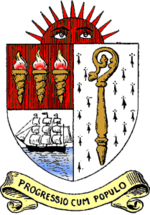County Borough of East Ham facts for kids
| East Ham | |
| Motto: Progressio cum Populo (Progress with the people) | |
 East Ham Town Hall |
|
 East Ham within Essex in 1961 |
|
| Geography | |
| Status | Local government district (1878—1894) Urban district (1894—1904) Municipal borough (1904—1915) County borough (1915—1965) |
| 1894 area | 3,324 acres (13.5 km2) |
| 1965 area | 3,324 acres (13.5 km2) |
| HQ | East Ham |
| History | |
| Created | 1894 |
| Abolished | 1965 |
| Succeeded by | London Borough of Newham |
Quick facts for kids Demography |
|
|---|---|
| 1901 population | 96,008 |
| 1961 population | 105,682 |
 |
|
| Subdivisions | |
| Type | Parishes |
| Units | East Ham (1878—1965) Little Ilford (1886—1900) |
East Ham was a special area in Essex, England, that managed its own local government from 1878 to 1965. It stretched from Wanstead Flats in the north to the River Thames in the south. To the west, it reached Green Street, and to the east, it went as far as Barking Creek. East Ham was also part of the London postal district and the area covered by the Metropolitan Police District.
Contents
How East Ham Was Governed
Early Local Management
East Ham first got its own local government in 1878. This happened when the local area of East Ham decided to form a "local board." This board was a group of nine people who helped manage things like public health and services in the area.
In 1886, a nearby area called Little Ilford joined East Ham. This made the local board bigger, with 12 members. A few years later, in 1894, a new law changed these local boards into "urban districts." This meant East Ham now had an elected council with 15 members to run things. In 1900, Little Ilford officially became a part of East Ham.
Becoming a Borough
On August 27, 1904, East Ham received a special document called a "royal charter." This important paper from the King or Queen officially made East Ham a "municipal borough." This meant it was a town with its own official town council.
The new council had a mayor, six senior council members called aldermen, and eighteen regular council members. The area was divided into six smaller sections called wards. Each ward elected three council members and one alderman.
Becoming a County Borough
In 1915, East Ham became even more independent. It was made a "county borough." This meant it managed its own affairs and didn't have to report to the main Essex County Council. The council grew bigger in 1920, with ten aldermen and thirty council members. They represented ten different wards across East Ham.
East Ham's Location and Services
The East Ham borough covered most of what is now the eastern part of the London Borough of Newham. This included areas like Little Ilford, Manor Park, East Ham itself, and Beckton. However, it did not include North Woolwich, which was historically part of another area.
East Ham used to have its own tram services, which were like public buses that ran on tracks. These were managed by the borough until 1933. The borough also had its own fire brigade, which later joined the London Fire Brigade in 1965. Today, East Ham's old Town Hall is used as the Newham Town Hall.
East Ham's Symbol
East Ham didn't have an official "coat of arms," which is a special design representing a town or family. Instead, it used a symbol created in 1896. This symbol had a few parts:
- A "crosier," which is a staff carried by a bishop, representing an old abbey from the 1100s.
- Burning torches, standing for the Beckton gasworks, which made gas for homes.
- A sailing ship, representing the docks and trade.
- A rising sun, symbolizing East Ham's fast growth.
Local Politics in East Ham
In the early days, local elections in East Ham were often not about political parties. Many times, candidates ran without competition.
In 1906, a local group linked to the national Labour Party was formed in East Ham. To oppose them, the local Conservative and Liberal groups formed something called the "Municipal Alliance." This group also included independent candidates.
In 1907, the Municipal Alliance won many seats, and the Labour Party became the main opposition on the council.
By 1929, the Labour Party gained control of the council and kept it for the rest of East Ham's existence as a borough. After World War II, the Labour Party faced official Conservative candidates. By the last elections in 1963, Labour held 30 seats, and independent candidates held 10.
End of the Borough
In 1965, the county borough of East Ham, along with another area called West Ham, was officially ended. Both became part of the new London Borough of Newham. This happened when Greater London was created, changing how London's local government was organized.
Population Changes
Here's how East Ham's population grew over the years:
| Year | 1801 | 1851 | 1861 | 1881 | 1891 | 1901 | 1911 |
|---|---|---|---|---|---|---|---|
| Population | <2000 | <2000 | 2,858 | 10,706 | 32,713 | 96,018 | 133,487 |
| Dwellings | n/a | n/a | 497 | 1,930 | 5,818 | 17,937 | 25,694 |
Images for kids



